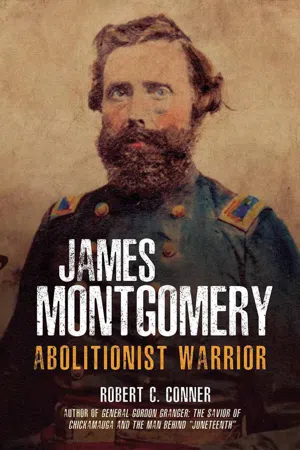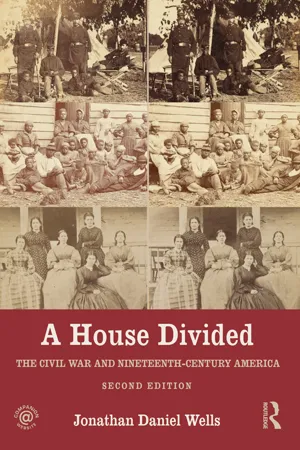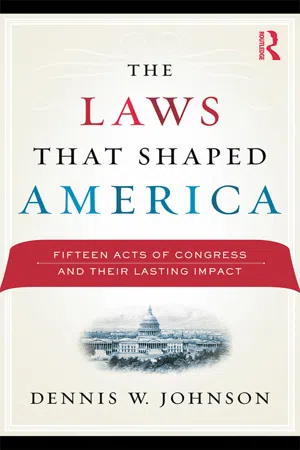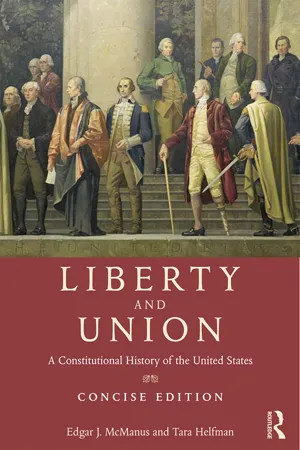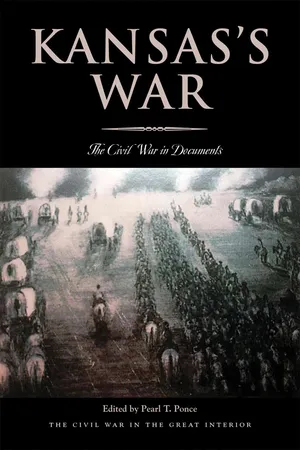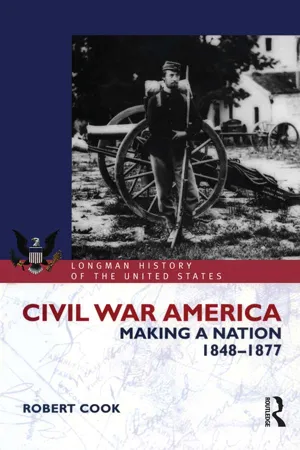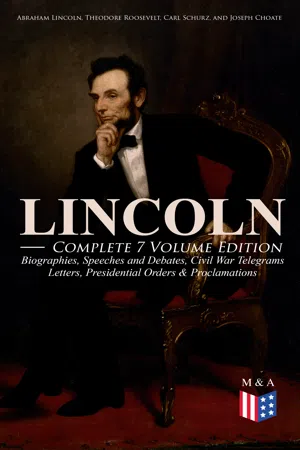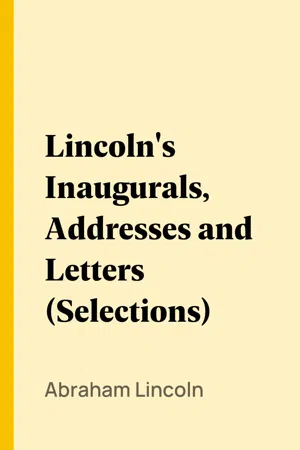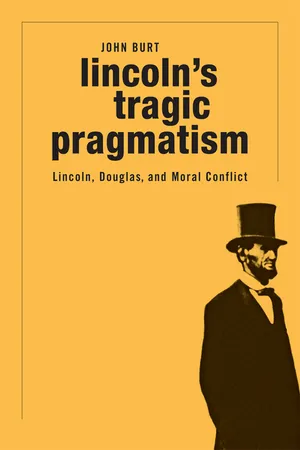History
Kansas-Nebraska Act
The Kansas-Nebraska Act of 1854 was a significant piece of legislation that allowed the territories of Kansas and Nebraska to decide for themselves whether to allow slavery, thus effectively repealing the Missouri Compromise of 1820. This act heightened tensions between pro-slavery and anti-slavery factions, leading to violent conflicts in Kansas, and ultimately contributed to the outbreak of the American Civil War.
Written by Perlego with AI-assistance
Related key terms
10 Key excerpts on "Kansas-Nebraska Act"
- eBook - ePub
James Montgomery
Abolitionist Warrior
- Robert C Conner(Author)
- 2022(Publication Date)
- Casemate(Publisher)
CHAPTER 2 Bleeding Kansas and John BrownThe Kansas-Nebraska Act was signed into law by President Franklin Pierce on May 30, 1854. Its main sponsor was Illinois Senator Stephen Douglas, a Democrat, and its main provisos included the creation of Kansas Territory (which extended well into modern-day Colorado) and Nebraska Territory to its north (also extending far to the west and north of the state’s present-day boundaries).More important, the new law allowed voters (meaning adult White males) of the western territories to decide for themselves whether future states to be created out of them should permit or prohibit slavery. This had the effect of overturning the geographic Missouri compromise line of 1820, which was mostly kept in place by its successor law of 1850, the preceding two major efforts by the federal government to peaceably resolve the issue of slavery. The 1850 law also had produced the Fugitive Slave Act, which was detested by all anti-slavery people and remained in effect. The Fugitive Slave Law which compelled northern states to act as slave catchers convinced many abolitionists that the federal government was profoundly corrupt on this issue, and that no peaceful or law-abiding advocacy for their cause was likely to succeed.Under the old Missouri compromise line, still in effect in the central part of the country until 1854, Kansas would have been designated a free state. Its repeal was seen by abolitionist and other anti-slavery politicians, including moderates like Abraham Lincoln, as the latest outrage perpetrated by the “slave power” which had such a grip on the federal government. But the new Kansas-Nebraska Act meant that the fate of Kansas was up for debate—and more direct action—by both sides of the slavery issue.Many Democrats, including Douglas, Pierce, and the future president James Buchanan, along with the mayors of major cities like New York, were northerners. But the party’s base was the slave-holding South. Most Democrats expected that residents of Missouri, a slave state, would move west across the border into Kansas, and turn that territory slave, too. In fact, in 1854, that appeared the most likely outcome to most independent observers, with Kansas becoming a slave state and Nebraska (to its north) a free one. Both sides, supporters and opponents of slavery, saw this struggle for the geographic heartland of the continent as crucial for the long-term success of their cause. In that judgment, both sides were correct. - eBook - ePub
Making an Antislavery Nation
Lincoln, Douglas, and the Battle over Freedom
- Graham A. Peck(Author)
- 2017(Publication Date)
- University of Illinois Press(Publisher)
5. Stephen A. Douglas and the Northern Democratic Origins of the Kansas-Nebraska Act, 1849–1854 RESOLVING NATIONAL CONFLICTS OVER slavery required a man of experience, influence, power, ability, ambition, decisiveness, and prudence. Stephen A. Douglas possessed all these traits in abundance, but one. A Vermonter by birth, he had migrated to Illinois in 1833, arriving with only five dollars to his name. He rose rapidly. Endowed with a razor-sharp mind, an extraordinary memory, a friendly manner, inexhaustible energy, and a deep, clear voice that boomed from his short, rotund frame, he quickly organized the state's Democratic Party and became known as its “Little Giant.” Elected in 1843 to the United States House of Representatives at age thirty and elevated to the Senate in 1846, he quickly achieved national renown, shepherding compromise measures through Congress in 1850 to pacify dangerous sectional discord. Thus by the early 1850s he had readied himself for greatness by joining experience, influence, and power to his widely recognized ability, ambition, and decisiveness. His future could not be known, but one contribution seemed likely. Territorial organization of the Great Plains, from which slavery had been barred by the Missouri Compromise in 1820, promised to aid land-hungry settlers, open a path for a transcontinental railroad, spur market exchange, augment national power, and strengthen the Democratic Party. There was only one hitch: securing the approval of southern politicians who believed that slavery had a claim on all national territories. As a partisan Democrat and an ardent Unionist, Douglas decided to serve the nation by substituting popular sovereignty for the Missouri Compromise's antislavery prohibition. His idea was highly imaginative, impressively bold, and astonishingly imprudent - eBook - ePub
A House Divided
The Civil War and Nineteenth-Century America
- Jonathan Wells(Author)
- 2016(Publication Date)
- Routledge(Publisher)
Chapter 1 ) that marked the northern most boundary of slavery’s reach. Southerners did not want another free state in the Union, especially when California had been admitted as a free state just a few years before. Free soil advocates were equally determined to keep Kansas and Nebraska closed to what they perceived as the debilitating and immoral effects of slavery. How would this crisis be solved?Illinois Senator Stephen Douglas, a popular Democrat and a leader in Congress, proposed a compromise. The line drawn at the 36˚30’ as part of the Missouri Compromise of 1820 would be declared null and void, superseded by popular sovereignty in which a vote of citizens within the new states would determine the status of slavery. In addition, Congress would divide the territory into two states, Kansas and Nebraska, with the latter almost certainly becoming a free state but with Kansas open to bondage. These stipulations became the Kansas–Nebraska Act of 1854, but like previous compromises, it failed to stem the tide of anger rising among antislavery and proslavery forces.The trouble erupted even before Kansas officially petitioned for statehood. Many northerners had come to Kansas with hopes of settling in a free state. They did not want slavery in Kansas and did not want to have to compete with slave labor. But in an election in March 1855, thousands of proslavery supporters from Missouri flooded over into Kansas to vote to make Kansas a slave state. The territorial capital of Lecompton, Kansas thus became proslavery. It seemed that, although the election was decided by fraudulent voting, Kansas would enter the Union as a slave state. But in the summer of 1855, supporters of a free Kansas set up a rival state government in Topeka. In the ensuing skirmish between proslavery and antislavery forces, many people died, creating a sense among many Americans that “Bloody Kansas” was merely a prelude to civil war. - eBook - ePub
The Laws That Shaped America
Fifteen Acts of Congress and Their Lasting Impact
- Dennis W. Johnson(Author)
- 2009(Publication Date)
- Routledge(Publisher)
121Douglas did not take part in much of the debate; he made his opening speech and then a final summation; more important was his role as floor manager. Salmon P. Chase was his leading opponent on the floor. The debate went on for four months, riveting the attention of the nation. “We are on the eve of a great national transaction,” said Seward, “a transaction that will close a cycle in the history of our country.” Charles Sumner pleaded against repeal of the Missouri Compromise, arguing that the true danger to the Union was not abandonment of the “peculiar institution” of the South, but the abandonment of freedom. “Not that I love the Union less, but Freedom more, do I now, in pleading this great cause, insist that Freedom, at all hazards, shall be preserved.”122Key Events in the Kansas–Nebraska Act1820 Missouri Compromise. 1832 Tariff of Abominations and South Carolina secession crisis. 1846 Texas annexation and Wilmot Proviso. 1850 Compromise of 1850. 1854 Kansas–Nebraska Act. 1857 LeCompton Constitution accepted by Buchanan; rejected by Senate in 1858. 1860 Presidential election. The Kansas–Nebraska bill, originally introduced by Douglas on January 4, 1854, passed the Senate on March 3. There had been a flurry of speeches and amendments, with a still angry Douglas, in a three-hour harangue, defending once again the principle of popular sovereignty and leveling a final salvo of invectives at his opponents. At five o’clock in the morning, after seventeen hours of debate, the final vote was taken: forty-one Senators voted for and seventeen against. The southern states were firmly for the law, but the northern states were bitterly divided. For the most part, Democrats were able to keep together, but discipline among Whigs had fallen apart along sectional lines. In late May, the legislation passed in the House, 115–104, thanks to considerable pressure by Douglas, Pierce, and his cabinet.123 - eBook - ePub
Liberty and Union
A Constitutional History of the United States, concise edition
- Edgar McManus, Tara Helfman(Authors)
- 2014(Publication Date)
- Routledge(Publisher)
Douglas’s critics charged that he backed repeal of the Missouri Compromise to promote his presidential ambitions in the South. Douglas had been a contender for the Democratic nomination in 1852 and clearly wanted to be president. If winning southern support had been his goal, he succeeded completely. Passage of the Kansas-Nebraska Act made him widely popular in the South and improved his presidential prospects. Douglas defended the act in the North as consistent with the Compromise of 1850. If popular sovereignty was acceptable for Utah and the New Mexico Territory, why not apply it in all the territories? Logically, he was right, but logic is not everything. Though a brilliant politician, Douglas was morally obtuse in failing to grasp what the debate was really about. It was not really about slavery in the territories but about the morality of slavery as an institution. His failure to grasp what should have been obvious would cost the nation dearly.The Kansas-Nebraska Act completed the disruption of the Whigs as a national political party. Already weakened by southern defections, the party now fell apart completely. Every northern Whig in Congress voted against the act, and all but seven of the southern Whigs voted for it. The Whigs thereafter disintegrated into sectional coalitions. The Democrats also suffered losses as thousands of antislavery northerners left the party in protest. But Democratic losses in the North were offset by gains in the South as former Whigs joined the party in droves. The political realignment tilted the balance of party power southward and increased the influence of southerners in party councils. The Democrats remained a national party, but the tilt southward gave them less leeway on the slavery issue than before.Emergence of the Modern Republican Party
The northern Whigs allied themselves with antislavery Democrats and Free-Soilers opposed to the Kansas-Nebraska Act, a coalition that evolved a year later into the modern Republican Party. The new party went considerably beyond opposition to the Kansas-Nebraska Act. The Republican platform called for the prohibition of slavery in the territories, repeal of the Fugitive Slave Law, and abolition of slavery in the District of Columbia. The Republicans could afford to take strong antislavery stands because they were exclusively a northern party. With no southern wing to accommodate, they could appeal solely to northern concerns and interests. Unlike the Whigs, whose broader base had helped to hold the country together, they became a divisive force in national political life. - eBook - ePub
Kansas's War
The Civil War in Documents
- Pearl T. Ponce, Pearl T. Ponce(Authors)
- 2011(Publication Date)
- Ohio University Press(Publisher)
ONE
Settlement and Strife
THE SECTIONAL CONFLICT that flared into war in 1861 shaped Kansas more than any other state in the Union. The last state admitted to the United States before the war, it was the first to experience the sectional conflict as more than a philosophical or constitutional disagreement. It was in Kansas that the country first realized that the political conflict between the sections could have a martial aspect, that it could lead to terror, violence, warfare, and even death. Initially, Kansas was like many other new territories, drawing settlers who sought a material improvement in their lives. But while many territorial residents arrived in Kansas to pursue economic opportunity, it is undeniable that the most prominent Kansans were ideologues. Because of this, the territory became a battlefront where Americans died for their beliefs.Yet the violence that broke out in the 1850s was an unintended consequence of the territory’s organization. Kansas had been carved from that part of the original Louisiana Purchase lands north of latitude 36°30', which marked the southern border of Missouri. By the terms of that state’s admission, in 1820, future states located north of this Missouri Compromise line would be free while states to its south would be open to slavery. However, when President Franklin Pierce signed the Kansas-Nebraska Act, in May 1854, Kansas was opened to settlement under the doctrine of popular sovereignty, allowing residents to determine their state institutions (notably slavery) for themselves. Although two previous territories, Utah and New Mexico, had been organized through popular sovereignty in 1850, that decision was an outgrowth of the Mexican-American War and a nod to the antislavery tradition in those lands. Pierce’s signature jettisoned a congressional compromise in effect for more than three decades. While its geography should have meant a free Kansas, residents now had the option to implant slavery. Within months of the 1854 Kansas-Nebraska Act, the territory became notorious for partisan strife that ranged from voter intimidation to electoral fraud to outright warfare, all in the effort to determine the future state’s eventual relationship to slavery. - eBook - ePub
Civil War America
Making a Nation, 1848-1877
- Robert Cook(Author)
- 2014(Publication Date)
- Routledge(Publisher)
The Kansas-Nebraska bill was condemned as ‘part and parcel of an atrocious plot’ to spread slavery into a vast area reserved for settlement by free men under the terms of the venerated Missouri Compromise. ‘Whatever apologies may be offered for the toleration of slavery in the States,’ contended the ‘Appeal’, ‘none can be urged for its extension into Territories where it does not exist… Let all protest earnestly and emphatically… against this enormous crime.’ 3 The ‘Appeal’ was an astute piece of political propaganda artfully designed to play on the inchoate fears and prejudices of the electorate. Americans knew the lessons of history. Republics were fragile entities constantly under threat from evil men and institutions conspiring to concentrate power and wealth in their own hands. The Revolution itself had taught the people that eternal vigilance was the only sure safeguard against encroaching tyranny. Chase and his allies in Congress were longstanding opponents of slavery – on humanitarian as well as political grounds – but they knew their audience well. The aim of the ‘Appeal’ was simple: to broaden the coalition against slavery, hitherto marginalized by the Compromise of 1850, by promoting a fundamental realignment of politics along sectional lines. What better way to do this than shake northern voters out of their lethargy by providing clear evidence that their own rights were under threat from a malign coterie of southern slaveholders who allegedly exercised a dominant influence over the Republic with the assistance of dupes like Stephen Douglas? The latter, then, had unwittingly presented his radical antislavery opponents with an opportunity to break the stranglehold of a party system that traditionally had operated to protect slavery. ‘My soul sickens at the names Whig & Democrat’, wrote the Massachusetts Free Soiler Charles Sumner privately - eBook - ePub
LINCOLN – Complete 7 Volume Edition: Biographies, Speeches and Debates, Civil War Telegrams, Letters, Presidential Orders & Proclamations
Including the Introduction by Theodore Roosevelt & 3 Biographies: The Every-day Life of the President, Lincoln by Carl Shurz and Abraham Lincoln by Joseph H. Choate
- Abraham Lincoln, Theodore Roosevelt, Carl Schurz, Joseph Choate, Francis F. Browne(Authors)
- 2017(Publication Date)
- Madison & Adams Press(Publisher)
The new year of 1854 found slavery excluded from more than half the States by State Constitutions, and from most of the National territory by Congressional prohibition. Four days later, commenced the struggle which ended in repealing that Congressional prohibition. This opened all the National territory to slavery, and was the first point gained.But, so far, Congress only had acted, and an indorsement by the people, real or apparent, was indispensable to save the point already gained, and give chance for more.This necessity had not been overlooked, but had been provided for, as well as might be, in the notable argument of "squatter sovereignty," otherwise called "sacred right of self-government," which latter phrase, though expressive of the only rightful basis of any government, was so perverted in this attempted use of it as to amount to just this: That if any one man choose to enslave another, no third man shall be allowed to object. That argument was incorporated into the Nebraska Bill itself, in the language which follows:"It being the true intent and meaning of this Act not to legislate slavery into any Territory or State, nor to exclude it therefrom, but to leave the people thereof perfectly free to form and regulate their domestic institutions in their own way, subject only to the Constitution of the United States."Then opened the roar of loose declamation in favor of "squatter sovereignty," and "sacred right of self-government." "But," said opposition members, "let us amend the bill so as to expressly declare that the people of the Territory may exclude slavery." "Not we," said the friends of the measure, and down they voted the amendment.While the Nebraska Bill was passing through Congress, a law case, involving the question of a negro's freedom, by reason of his owner having voluntarily taken him first into a free State, and then into a territory covered by the Congressional Prohibition, and held him as a slave for a long time in each, was passing through the United States Circuit Court for the District of Missouri; and both Nebraska Bill and lawsuit were brought to a decision in the same month of May, 1854. The negro's name was "Dred Scott," which name now designates the decision finally made in the case. Before the then next Presidential election, the law case came to, and was argued in, the Supreme Court of the United States; but the decision of it was deferred until after the election. Still, before the election, Senator Trumbull, on the floor of the Senate, requested the leading advocate of the Nebraska Bill to state his opinion whether the people of a territory can constitutionally exclude slavery from their limits; and the latter answers: "That is a question for the Supreme Court." - Abraham Lincoln, Daniel Kilham Dodge, (Authors)
- 2004(Publication Date)
- Perlego(Publisher)
The new year of 1854 found slavery excluded from more than half the States by State constitutions, and from most of the national territory by Congressional prohibition. Four days later commenced the struggle which ended in repealing that Congressional prohibition. This opened all the national territory to slavery, and was the first point gained.But, so far, Congress only had acted, and an indorsement by the people, real or apparent, was indispensable, to save the point already gained, and give chance for more.This necessity had not been overlooked, but had been provided for, as well as might be, in the notable argument of "squatter sovereignty," otherwise called "sacred right of self-government," which latter phrase, though expressive of the only rightful basis of any government, was so perverted in this attempted use of it as to amount to just this: That if any one man choose to enslave another, no third man shall be allowed to object. That argument was incorporated into the Nebraska bill itself, in the language which follows: "It being the true intent and meaning of this act not to legislate slavery into any Territory or State, nor to exclude it therefrom; but to leave the people thereof perfectly free to form and regulate their domestic institutions in their own way, subject only to the Constitution of the United States." Then opened the roar of loose declamation in favor of "Squatter Sovereignty" and "sacred right of self-government." "But," said opposition members, "let us amend the bill so as to expressly declare that the people of the Territory may exclude slavery." "Not we," said the friends of the measure; and down they voted the amendment.While the Nebraska bill was passing through Congress, a law case involving the question of a negro's freedom, by reason of his owner having voluntarily taken him first into a free State and then into a Territory covered by the Congressional prohibition, and held him as a slave for a long time in each, was passing through the United States Circuit Court for the District of Missouri; and both Nebraska bill and lawsuit were brought to a decision in the same month of May, 1854. The negro's name was "Dred Scott," which name now designates the decision finally made in the case. Before the then next presidential election, the law case came to and was argued in the Supreme Court of the United States; but the decision of it was deferred until after the election. Still, before the election, Senator Trumbull, on the floor of the Senate, requested the leading advocate of the Nebraska bill to state his opinion- eBook - ePub
- John Burt(Author)
- 2013(Publication Date)
- Belknap Press(Publisher)
52 This argument, too, Lincoln rightly saw as fishy, comparing it to the claim that if one does not build onto a house then one has somehow forfeited that house. But Douglas was right to argue that when the slave states balked at organizing Kansas as a free territory under the Missouri Compromise restriction they were not behaving terribly differently from the way the free states had behaved in 1821.The pragmatic claim that repealing the 36° 30′ line provision of the Missouri Compromise, combined with the proviso that slavery could not prosper in Kansas anyway, was the only way to organize territorial governments in the face of southern opposition was probably Douglas’s strongest argument, and, for that matter, probably also renders his actual motivations. But Douglas also argued that his position was not only consistent and principled but in the spirit of the Compromise of 1850. Why did he make this claim?For one thing, Douglas could claim that the politicians who most opposed him about the Kansas-Nebraska Act were opponents of the Compromise of 1850 to begin with, and thus were in no position to speak of its meaning or treat it as a sacred compact that Douglas, who was after all both the principal author of the compromise and the manager of its adoption, had shattered. As Douglas had said at the time:They talk about the bill being a violation of the compromise measures of 1850. Who can show me a man in either house of Congress who was in favor of those compromise measures in 1850, and who is not now in favor of leaving the people of Nebraska and Kansas to do as they please upon the subject of slavery, according to the principle of my bill? Is there one? If so I have not heard of him. The tornado has been raised by abolitionists, and by abolitionists alone.53Douglas was probably right about who his opponents were (remembering how the compromise was reached), although he was wrong in Lincoln’s case. Certainly Chase, Sumner, and Giddings, the most vociferous opponents of the Kansas-Nebraska Act, were no sympathizers with the Compromise of 1850. And Douglas knew how people behave when they have made a deal they begrudge: his speeches during the spring of 1854 were full of examples of how northern politicians who signed onto the Missouri Compromise spent years trying to evade it, and only discovered that it was something to revere when Douglas sought to repeal it.54 Indeed, as Douglas pointed out in a letter responding to a protest from thirty-five Chicago clergymen about the Kansas-Nebraska Act, many of those who gave speeches about the sacredness of the compact enshrined in the Missouri Compromise had been doing their best to subvert the Fugitive Slave Act, which was the product of exactly the same kind of deal.55
Index pages curate the most relevant extracts from our library of academic textbooks. They’ve been created using an in-house natural language model (NLM), each adding context and meaning to key research topics.
